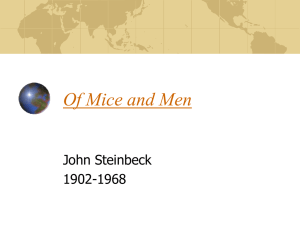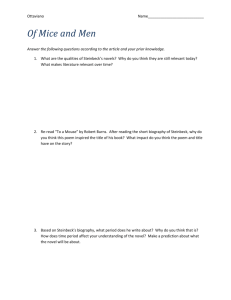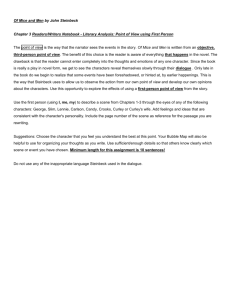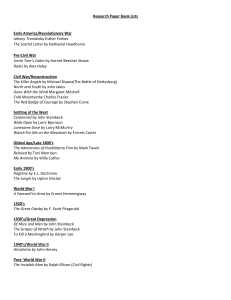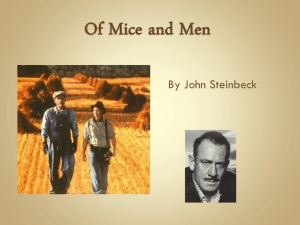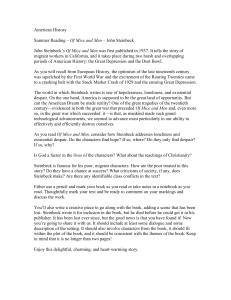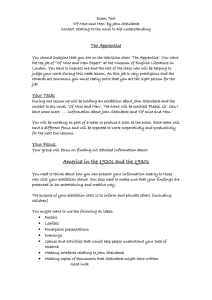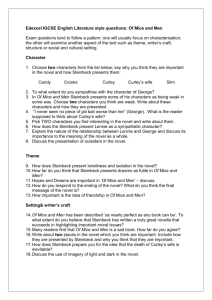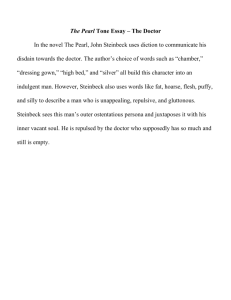The Grapes of Wrath John Steinbeck
advertisement
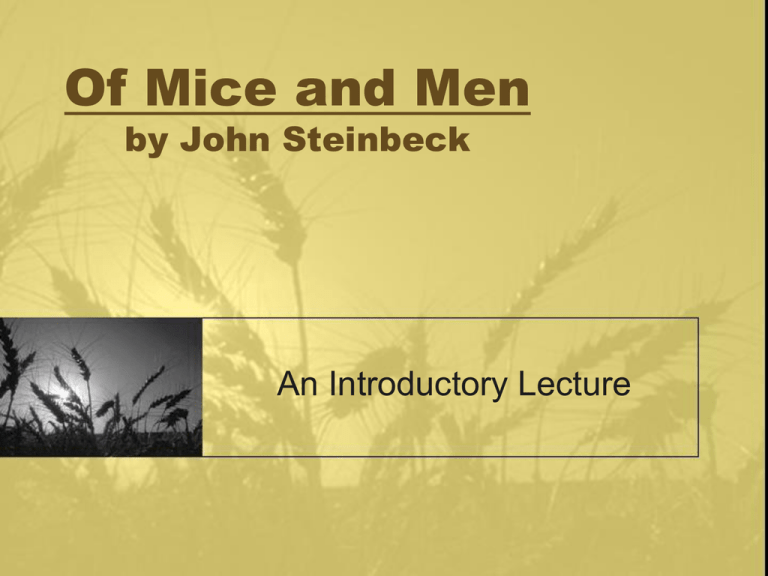
Of Mice and Men by John Steinbeck An Introductory Lecture Cornell Notes • Topic: Of Mice and Men • Objectives: – Students will become familiar with America in the 1930s. – Students will understand how Steinbeck created a powerful novel that is still read today. Cornell Notes Format Format your paper to look like the image below: Questions We will add the questions to our notes later. Notes Fill the “Notes” section with words, pictures, numbers, facts, and quotes from today’s lecture. Words are important but the notes need not end there. The Great Depression • Began with Black Thursday – October 24, 1929, NY Stock Exchange crashed • The worst/longest period of high unemployment and low-business activity in the history of the United States • Exacerbated by severe drought in the mid-west commonly referred to as “The Dust Bowl” • Ends when America enters into WWII in 1941 The Great Depression • Many people lost their life savings, were forced to worry about necessities (food, clothing, shelter) • By 1932, 1 out of every 4 Americans was unemployed – Currently the US unemployment rate is 5.6% • Farm income fell 50%; farms were purchased by large corporations The Dust Bowl: 1934-36 What Was Left Behind Migrating to California Hoovervilles Named for President Herbert Hoover who was given blame for The Depression. Hoovervilles were the nicknames for shanty towns that went up by homeless people in the 1930s, usually in urban areas. “The Promised Land” Upper left: workers picking lettuce Upper right: “Hooverville” Bottom: Farm workers in line for “work cards” John Steinbeck 1902-1968 John Steinbeck 1902-1968 “In every bit of honest writing in the world there is a base theme. Try to understand (people), if you understand each other you will be kind to each other. Knowing a (person) well never leads to hate and nearly always leads to love. There are shorter means, many of them. There is writing promoting social change, writing punishing in-justice, writing in celebration of heroism, but always that base theme: Try to understand each other.” - John Steinbeck in his 1938 journal entry John Steinbeck • Of Mice and Men published in 1937 • Novella(short novel): attempted writing a play novelette. 3 acts of 2 chapters each. • Much of his work was during the 30’s – Dealt with social issues, particularly in CA • Researched migrant worker conditions – Made journey from Oklahoma, living in camps (authentic, first-hand experience) • Won the Nobel Prize in Literature in 1962 • Died in 1968 at the age of 66 Plot Overview • Main characters: George Milton and Lennie Small – two friends who are migrant workers in Salinas, CA – They are working towards their big dream • Action in the novel takes place over three days (begins Thursday night and ends Saturday night) Novel Style Play/Novelette – Develops the characters through speech and action rather than letting the reader in on their thoughts (third person point of view) – Starts each scene (or chapter) with a description of setting, just as a play is staged around its sets Stop – Adding Questions • Go back and write in a few QUESTIONS in the left-hand column. • The goal is to write questions that would be similar to a test or quiz question! • Example: Off to the left, you could write: • “During the 1930s, what natural event increased the seriousness of the Depression?” • Add at least FOUR (4) questions. Themes • Friendship (human relationships) • Loneliness • The worth of individual life • Social inequality • A person’s fate in a fallen world (hope vs. hopelessness) Novel’s Setting: Salinas Valley, CA San Francisco Salinas Soledad Pacific Ocean Novel’s Setting: Salinas Valley, CA Literary Terms Foreshadowing – Clues about future events in the story Symbolism – The practice of representing things by means of symbols or of attributing symbolic meanings or significance to objects, events, or relationships. Why is this book banned? #1. Language swear words offensive language racial segregation Why does this appear in literature? Adding more questions • Add a few more questions to the left-hand column of your notes. • Remember – your goal is to write questions that are similar to a test or quiz question. Summary of Notes •At the bottom of your notes write a 34 sentence summary of the notes you have just completed. •Study these notes – we will have a quiz on them tomorrow. Journal Entry #1 Essential Questions • POWER – What inequalities exist in society? – How has this changed over the years? • IDENTITY – How do you characterize others? – Do your impressions often change after you first meet them? Write a minimum one-page journal entry responding to any or all of the above questions. Journal Entry #2 Title Analysis “The best laid plans of mice and men often go awry.” --poet Robert Burns • • • • What is Robert Burns saying? Paraphrase his words. Do you think there is truth to Burns’ words? Why or why not? Why might Steinbeck have chosen Burns’ words to title his story? Do you think it’s an appropriate title for the story? Why or why not? (If not, come up with a better title and explain your choice.) Write a minimum one-page journal entry responding to any or all of the above questions. Journal Entry #3 1962 Nobel Prize Speech “. . . the writer is delegated to declare and to celebrate man’s proven capacity for greatness of heart and spirit—for gallantry in defeat, for courage, compassion and love. In the endless war against weakness and despair, these are the bright rally flags of hope and of emulation. I hold that a writer who does not passionately believe in the perfectibility of man has no dedication nor any membership in literature.” • What is Steinbeck saying? Paraphrase his words. • Do you agree with what he’s saying? Why or why not? • Does Of Mice and Men fit with this philosophy? Support your answer with specific examples from the text. Write a minimum one-page journal entry responding to any or all of the above questions.
